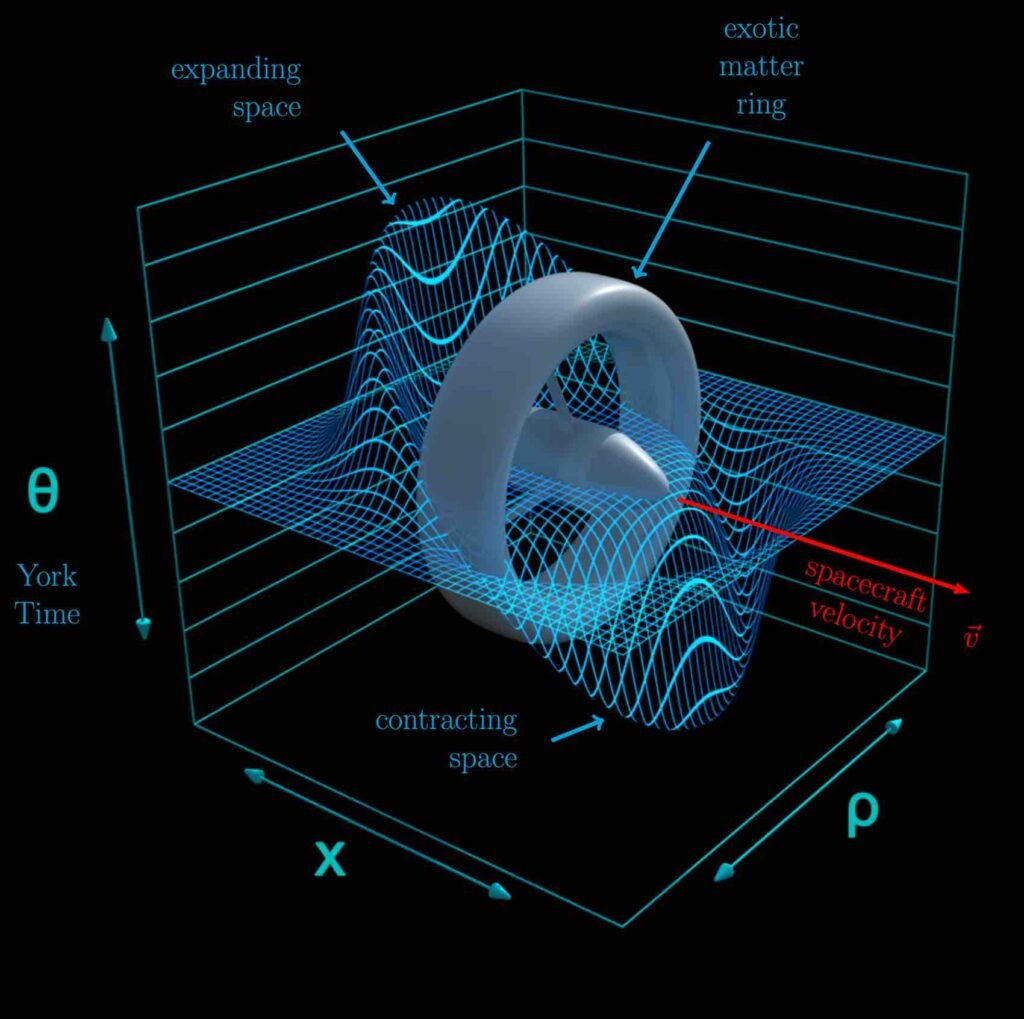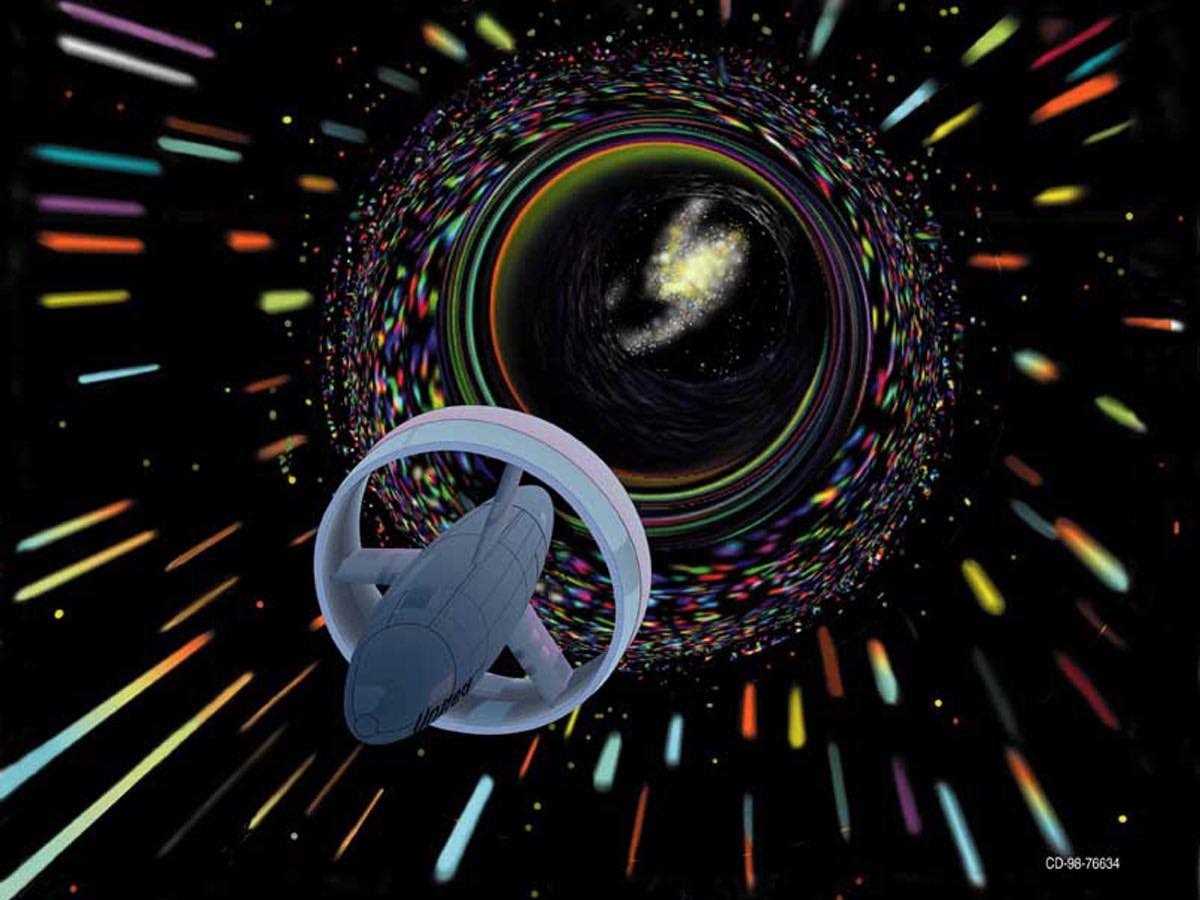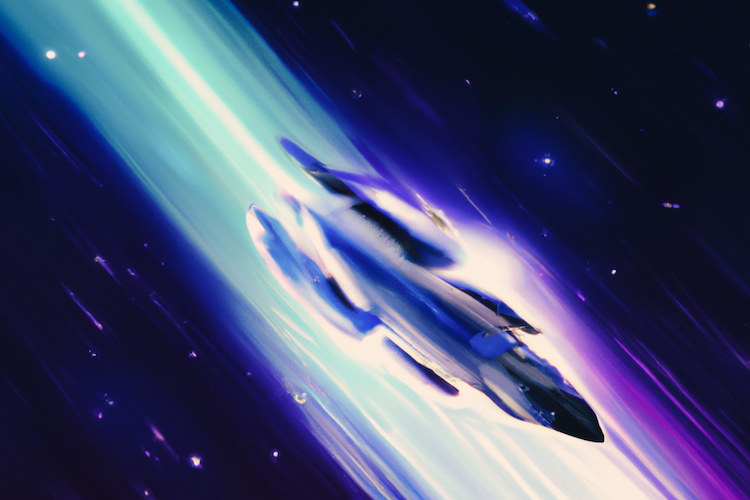Since Captain Kirk first ordered the Starship Enterprise to engage the warp drive back in 1967, fans of science fiction have dreamed of traveling to the stars at warp speed. That idea remained in the realm of science fiction until 1994, when Mexican mathematician Miguel Alcubierre proposed a mathematically viable solution for building a real-world faster-than-light warp drive.
Since then, numerous scientists and engineers have taken a swing at their own version of a viable, real-world warp drive, including an attempt to patent one of these “out there” ideas.
Here, The Debrief looks at three of the past most promising warp drive models, along with one brand new physics concept called the “Tri-Space Model,” which may hold the key to making faster-than-light travel possible.
The Original: Alcubierre/White Warp Drive
While Alcubierre’s warp drive concept showed that traveling faster than light was mathematically possible, it was widely criticized for its massive power requirements and use of purely theoretical “exotic matter.” Still, many scientists and engineers were intrigued by his work, including former NASA engineer and physicist Dr. Harold G. “Sonny” White.
Hoping to move Alcubierre’s metric from theory into a published, canonical form, White first looked at the idea more closely in 2003.
“I started working in the (NASA) space program in 2000,” White told The Debrief in an interview. “While I was working in the space program, I was thinking about this Advanced Power propulsion. I was thinking about this Alcubierre Warp metric. You know, it was not published in its canonical form. And so, in 2003, I published a paper in the journal General Relativity and Gravitation.”
White immediately noted how Alcubierre’s math worked but also spotted areas he thought his own background in engineering and physics could improve the concept.
“Some things didn’t quite make sense to me, but by putting it into canonical form, helped me figure out ‘how does this concept really work?’, White told The Debrief. “From the process of not being at warp to being at warp… what would that look like when you look at the mathematics? And the only way I could see to answer the question is to put it in the canonical form in 2003, so that’s what I talked about in that paper.”


Years later, White was asked by NASA to present his updated warp concept, leading to his 2011 paper and the warp drive concept now known as the “Acubierre/White Warp Drive.”
“I got asked to give a talk [about the warp drive] to DARPA and NASA at the DARPA 100-year Starship Symposium in 2011,” he told The Debrief. “I did a sensitivity study on the metric. I looked at what happens when you change the parameters and the mathematics.”
Specifically, White looked at the geometry of the classic warp drive model and found something that dramatically reduced the amount of energy required by Alcubierre.
“It basically comes down to how thick you make the toroidal ring and negative vacuum energy density,” he explained. “How thick or thin to make it, topologically? What does that do to the overall energy required? And so, during that work, I had no ‘objective’ objectives, per se, other than just to explore. In the process of doing that, I discovered that by making that ring a little thicker, instead of being like a wedding band wrapped around your finger, it’s a little bit more like a lifesaver, was key.”
In fact, White’s geometric adjustment to the classic model dramatically reduced the amount of exotic matter required to a much more manageable concept.
“By using that optimization technique, I was able to reduce the amount of exotic matter from a Jupiter-sized amount down to something about the size of the Voyager spacecraft,” said White. “So about two metric tons or just under two metric tons.”
As White notes, even a few tons of a theoretical substance like exotic matter is still unachievable by today’s scientists and engineers, but his changes definitely improved the ultimate viability of Alcubierre’s idea.
“Instead of just being mathematically possible in our work, we potentially move it into the category of maybe it’s plausible,” he noted with a lighthearted shrug. “There are now two metric tons of this stuff we’re not quite sure exactly how to make.”
White’s views about the feasibility of warp drives and their related effects have garnered a fair amount of attention from critics over the years. Among them is astrophysicist Ethan Siegel who, while remaining skeptical of White’s claims, has noted that the warp drive concept “remains an interesting possibility and one worthy of continued scientific investigation, but one that you should remain tremendously skeptical about given the current state of affairs.”
The Lentz Drive
A decade after White updated the original warp drive concept, reducing the need for exotic matter down from a Jupiter-sized amount to a few tons, another scientist named Dr. Eric W. Lentz decided to take a stab at his own warp drive concept. Published in 2021, his paper “Breaking the warp barrier: hyper-fast solitons in Einstein–Maxwell-plasma theory” lays out a whole new warp drive concept. And unlike Alcubierre and White, Lentz believed that his faster-than-light warp drive model could be accomplished in a completely new and different way.
“The Alcubierre solution provided an intuitive picture of what a warp drive would do: contract the space immediately in front of the central region containing the ship or transport, and expand the space immediately behind,” Dr. Lentz explained in an email to The Debrief. “This gives us the picture of the warp drive as a wave of curvature on which a ship will ride to its destination.”
However, Lentz explains, “this picture is not an essential feature of a warp drive.” Instead, he says, a solution proposed by physicist Jose Natario back in 2002 showed that the expansion and contraction weren’t necessary to transport the ship forward. That work, says Lentz, was critical to forming his own theory, one where a warp field could be created using only traditional matter and not exotic matter.
“[Natario] showed that the expansion could be trivial (zero) everywhere and still perform the same task of transporting a ship,” Lentz told The Debrief. This is a significant breakthrough, he says, because it means that exotic matter that warps the space in front of the theoretical passenger, as well as behind them (as depicted in nearly all theoretical warp drive solutions), is no longer needed to achieve faster-than-light travel.


“In the Alcubierre solution, the energy density and curvatures are maximally separated, with the energy being restricted to a small torus between the regions of high contraction and expansion,” Lentz told The Debrief, once again evoking the classic image of the Alcubierre Warp model. “The curvatures and sources in my proposal are instead highly correlated, with the regions of high energy density and high expansion and contraction overlapping almost exactly.”
As his published paper explains, “This is the first example of hyper-fast solitons resulting from known and familiar sources, reopening the discussion of superluminal mechanisms rooted in conventional physics.”
Lentz does freely admit that his theory is somewhat novel, even in this highly theoretical arena. “The expansion factor in my proposal is stranger still [than in Natario or Alcubierre], having regions of large expansion and contraction of space surrounding the central region containing a ship.”
Still, the issue of power requirements is not totally solved by Lentz, although he told The Debrief there is some hope in this area.
“There are a number of very effective energy-saving mechanisms for the Alcubierre drive described in the literature,” he explained. “The challenge would be to either modify these mechanisms to operate using only conventional sources, [like his proposed theory which does not require exotic matter] or to innovate novel energy saving techniques.”
In other words, if these proposed energy reduction techniques don’t work on his drive concept due to the lack of exotic matter, a legitimate concern, then an entirely new solution, the likes of which has not yet been proposed, would need to be found. Fortunately, Lentz says, his drive already accomplishes some of that goal since “not all the energy needs to come directly from the reactor, as we expect much of the energy sourcing the bubble to come from the particles’ rest masses.”
Those particles, known in physics as solitons, are at the heart of the Lentz solution to faster-than-light travel and, aside from any theoretical attempts to further reduce energy needs, are something he believes represents the most viable area for future, practical testing. Lentz told The Debrief he sees a handful of reasonable goals going forward, including zeroing in on a viable energy level for a real-world, testable drive concept using only current power generation technology.
“After the energy requirements are low enough and suitable means of creating such solitons has been found, I would want to have the existence of such solitons confirmed in a laboratory setting for a small (~1m radius), slow (~km/s speed), but detectable soliton,” he said. “The target energy level is where a bubble of radius ten meters moving at 1% of the speed of light could be powered by a modern-day fission reactor.”
Although he is obviously enthusiastic about his novel solution to faster-than-light travel without exotic matter, Lentz also told The Debrief he is excited about all of the new, innovative concepts being discussed.
“It has been exciting to see how much progress has been made in this field recently,” he said, “and I think there are many more advances ready to be made. I am looking forward to seeing what the next few years bring.”
Applied Physics Warp Concept
Sometimes slower is better, especially when you want to avoid using “exotic matter” to make your theory work. Enter the Applied Physics (APL) Group. Their designs were recently published in the peer-reviewed journal Classical and Quantum Gravity and represent the latest in an increasingly crowded field of warp proposals.
Unlike the Alcubierre and White designs, the APL team shuns exotic matter as a power source. However, sacrifices need to be made. The physical nature of APL’s design means it is constrained by Newtonian physics. In short, while their drive concept is indeed designed to transport humans across the galaxy, it is not capable of breaking the speed of light. Damn.
“There is a common misconception that interstellar travel has to be superluminal,” Gianni Martire told The Debrief last year, “it doesn’t. If we can send a probe to reach another star within ten years, it is still incredibly useful.”
And while Sci-fi fans have the itch to go fast, APL’s warp drive doesn’t have the same energy requirements and, therefore, radiation, which tends to be a massive problem in building a crewed warp-capable vessel. Basically, no one gets cooked to death when they hit Warp Factor 1.
“Before our paper,” Martire says, “saying such things [like warp] was nonsense sci-fi. Now it’s real science. We took a small step into the future, do you feel it?”
The Tri-Space Model
It all began in college when a young science fiction buff, future engineer, and Senior Project Leader for The Aerospace Corporation, Gregory Meholic, stumbled upon a curious little pamphlet made by the RAND Corporation.
“It was on Tachyon particles and their potential for faster-than-light travel and motion,” Meholic explained to The Debrief. “And I mean, lots of science fiction uses tachyons as the go-to faster-than-light widget, right?”
That RAND pamphlet was an exploratory work in speculative physics written by Lt. Col. Edward Puscher for the United States Air Force in 1980. It explores the theory regarding a theoretical particle called a tachyon that may exist in a permanent faster-than-light state.
“Basically, it was an algebraic solution to the general and special relativity equations that govern motion near the speed of light,” Meholic explained.
A big kick in the FTL pants for any science fiction fan is Einstien’s Theory of Relativity. The closer you get to light speed, the more your mass increases. As you near the 300,000 kilometers per second mark (the speed of light), you require an infinite amount of energy to hit light speed.
“And this pamphlet basically was trying to show that, first, Tachyons can theoretically exist in a super-liminal realm,” says Meholic. “And second, it provided the logical algebraic follow-outs of special and general relativity to show their characteristics.”


After Meholic read the pamphlet, it tweaked his imagination.
“What occurred to me in reading this was that three possible velocities could be associated with any given point in space: sub-light, light speed, and superluminal travel,” he explained.
So, in a nutshell, Meholic’s Tri-Space Theory breaks up reality into three “realms” that coexist at any point in spacetime. The sub-light realm is everything that moves slower than the speed of light, like your old Honda Accord or that barista at your regular coffee shop. The light-speed realm is the world of the massless photon zipping around at the 300,000 kps speed limit. And then there is the superliminal realm where things like tachyons dwell. Once you go beyond the math curve that brings you to light speed, the math doubles back.
“So when I started to think about this ‘other side of the curve,’ so to speak, what happens in this superluminal realm is really interesting because when you take energy away from the system, you go faster,” says Meholic.
In our realm, sub-light, the more energy you put into travel, the faster you go. In the superliminal realm, beyond the algebraic curve, as Meholic says, the more energy you put into travel, the slower you go, eventually bumping into the crawling 300,000 kps limit, but from the topside. To slow down to the speed of light, a superliminal object would require an infinite amount of energy; almost like a backward theory of relativity.
“And this implies that the rest mass becomes imaginary, which is the whole square root negative one thing…And so, as long as you’re moving faster than light speed, this particular algebraic solution says that tachyon particles could have a real positive mass traveling at these superluminal speeds,” Meholic postulates.
And for science fiction fans who need their ship to get from Earth to Wolf 359 in a hurry, the idea that something can have mass and achieve faster-than-light travel solves the whole cosmic speed limit issue. The Tri-Space Model doesn’t violate the rules because the superliminal object exists outside the sub-light and light-speed realms. No causality issues. No weird time dilations. No accidental time travel. No infinite mass problems. Just open superliminal space.
Sounds fun, but it begs one big question: How?
For an object to exist in superliminal space, it must jump from this realm to the superliminal realm. The idea isn’t to speed up to superliminal speed but to pop into it. And the best way to do that is to convert ordinary dull sub-light matter into a version that can exist in the superliminal realm. So how does someone build the machine to make such a conversion possible? Zero clue.
While Meholic’s idea is still very much speculative, it is unique. It doesn’t require a warp in spacetime or a wormhole or much in the way of new math. It is very similar to dark matter and dark energy; the biggest challenge is that we cannot currently observe the superliminal, so to say a “superliminal realm” exists becomes a matter of theoretical physics.
In sum total, we are still a long way from making the concept of faster-than-light travel anything more than just an entertaining element of science fiction. However, with the work of scientists like these who remain dedicated to its study, this fictional form of travel may indeed one day make its way into the realm of science fact.
Follow and Connect with Christopher Plain on Twitter @plain_fiction.
Follow MJ Banias on Twitter @mjbanias.

